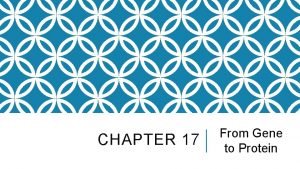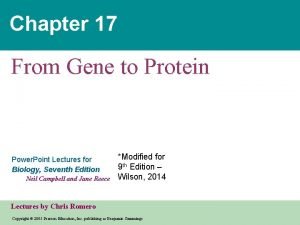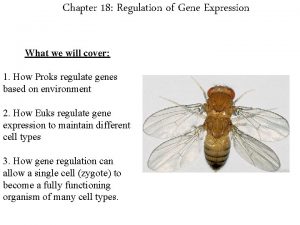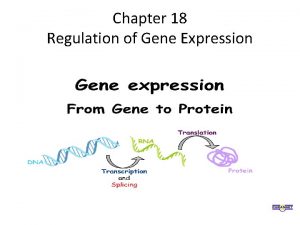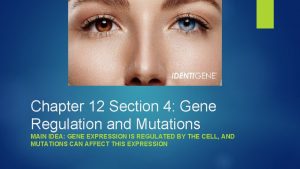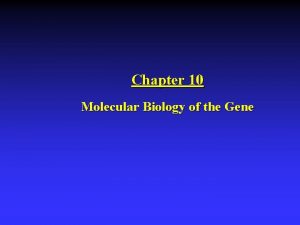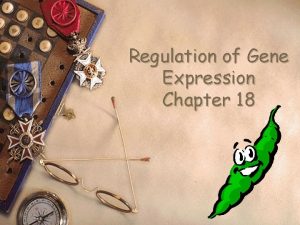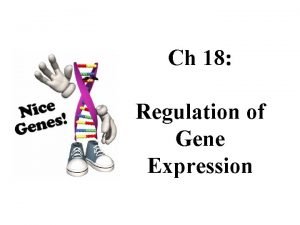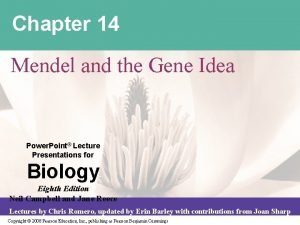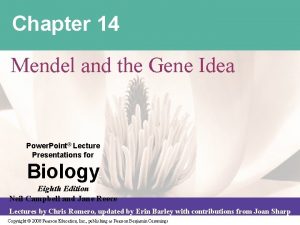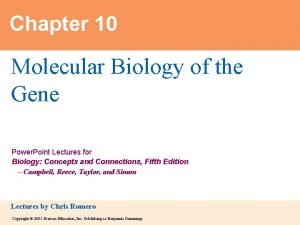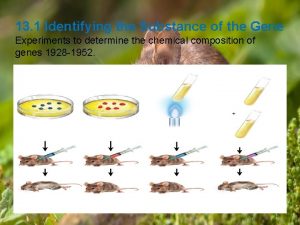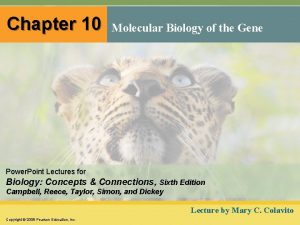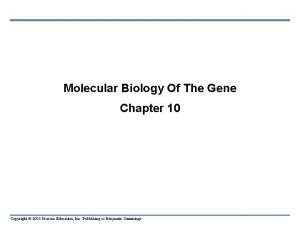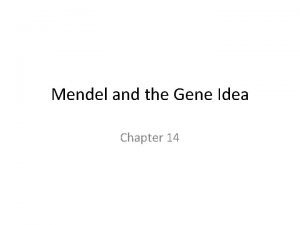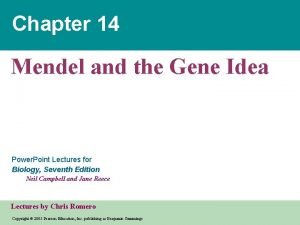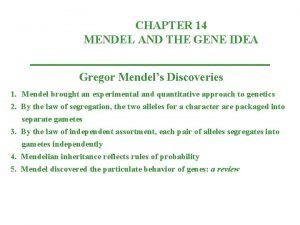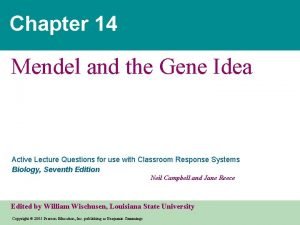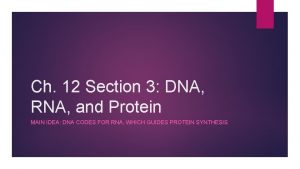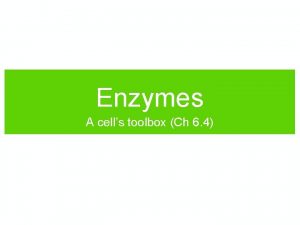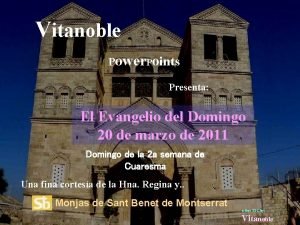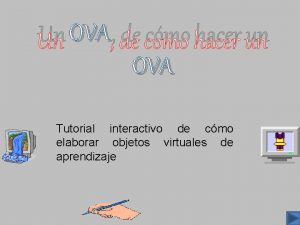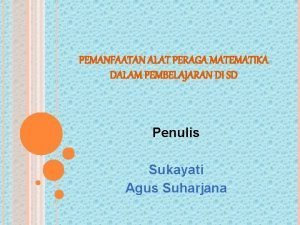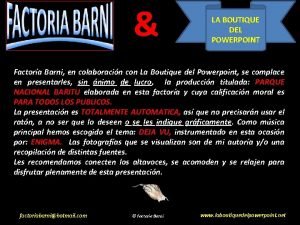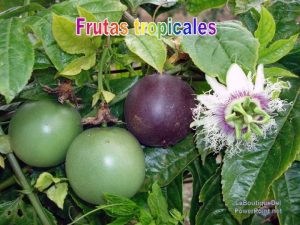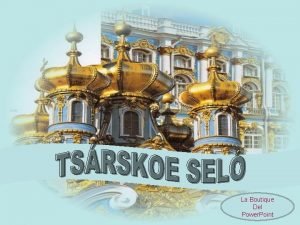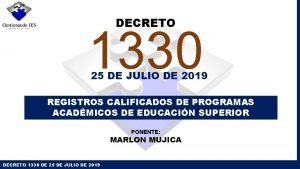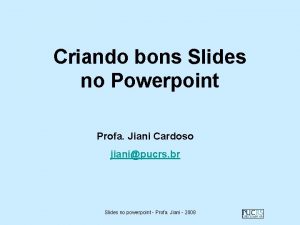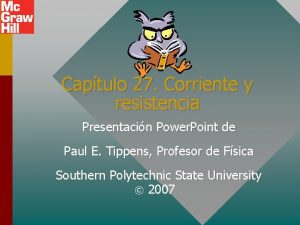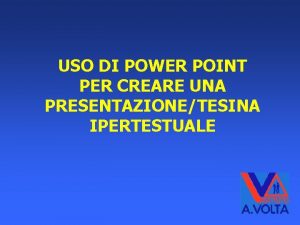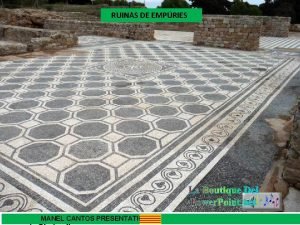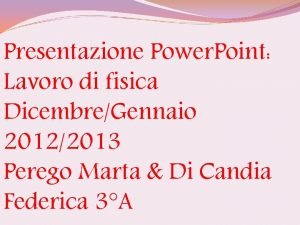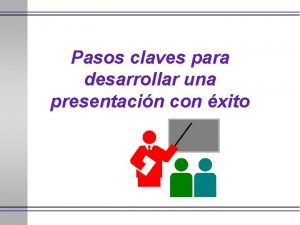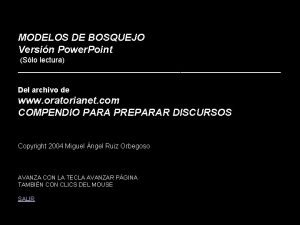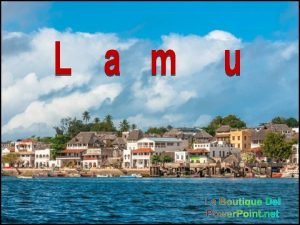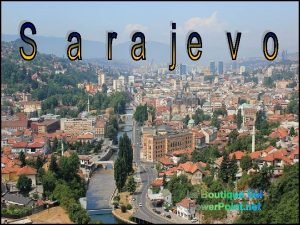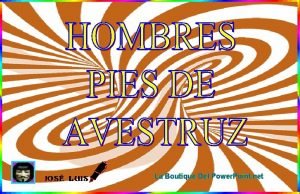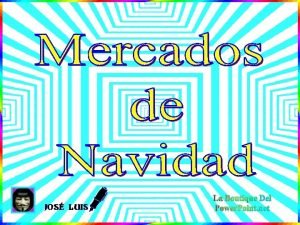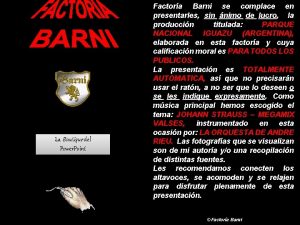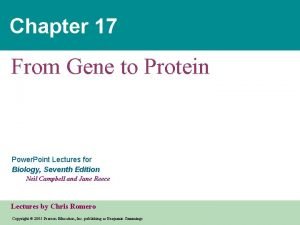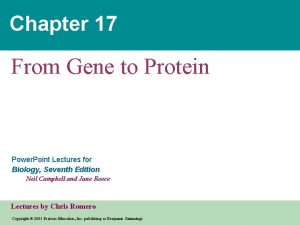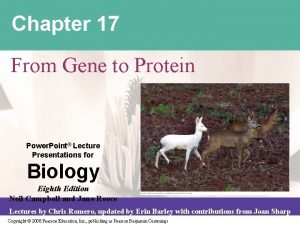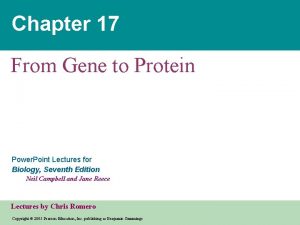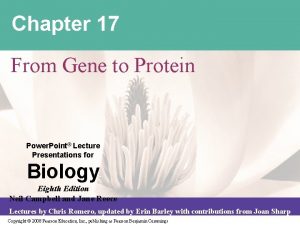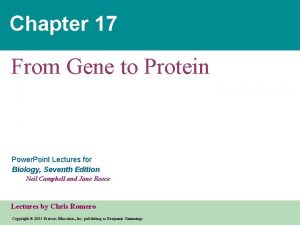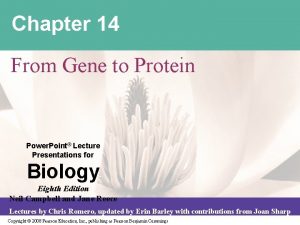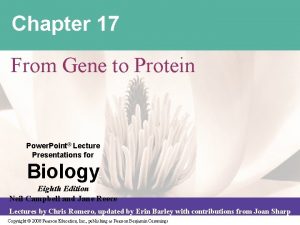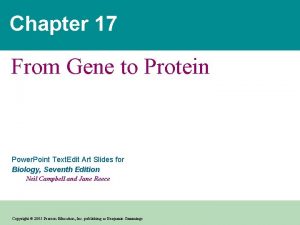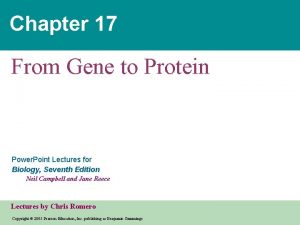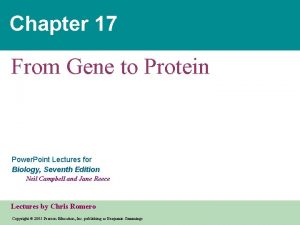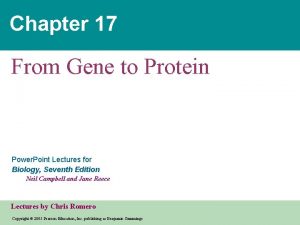Chapter 17 From Gene to Protein Power Point






































































- Slides: 70

Chapter 17 From Gene to Protein Power. Point Lectures for Biology, Seventh Edition Neil Campbell and Jane Reece Lectures by Chris Romero Copyright © 2005 Pearson Education, Inc. publishing as Benjamin Cummings

• Overview: The Flow of Genetic Information • The information content of DNA – Is in the form of specific sequences of nucleotides along the DNA strands Copyright © 2005 Pearson Education, Inc. publishing as Benjamin Cummings

• The DNA inherited by an organism – Leads to specific traits by dictating the synthesis of proteins • The process by which DNA directs protein synthesis, gene expression – Includes two stages, called transcription and translation Copyright © 2005 Pearson Education, Inc. publishing as Benjamin Cummings

• The ribosome – Is part of the cellular machinery for translation, polypeptide synthesis Figure 17. 1 Copyright © 2005 Pearson Education, Inc. publishing as Benjamin Cummings

• Concept 17. 1: Genes specify proteins via transcription and translation Copyright © 2005 Pearson Education, Inc. publishing as Benjamin Cummings

Evidence from the Study of Metabolic Defects • In 1909, British physician Archibald Garrod – Was the first to suggest that genes dictate phenotypes through enzymes that catalyze specific chemical reactions in the cell Copyright © 2005 Pearson Education, Inc. publishing as Benjamin Cummings

Nutritional Mutants in Neurospora: Scientific Inquiry • Beadle and Tatum causes bread mold to mutate with X-rays – Creating mutants that could not survive on minimal medium Copyright © 2005 Pearson Education, Inc. publishing as Benjamin Cummings

• Using genetic crosses – They determined that their mutants fell into three classes, each mutated in a different gene EXPERIMENT RESULTS Working with the mold Neurospora crassa, George Beadle and Edward Tatum had isolated mutants requiring arginine in their growth medium and had shown genetically that these mutants fell into three classes, each defective in a different gene. From other considerations, they suspected that the metabolic pathway of arginine biosynthesis included the precursors ornithine and citrulline. Their most famous experiment, shown here, tested both their one gene–one enzyme hypothesis and their postulated arginine pathway. In this experiment, they grew their three classes of mutants under the four different conditions shown in the Results section below. The wild-type strain required only the minimal medium for growth. The three classes of mutants had different growth requirements Wild type Minimal medium (MM) (control) MM + Ornithine MM + Citrulline Figure 17. 2 MM + Arginine (control) Copyright © 2005 Pearson Education, Inc. publishing as Benjamin Cummings Class I Mutants Class III Mutants

CONCLUSION Gene A From the growth patterns of the mutants, Beadle and Tatum deduced that each mutant was unable to carry out one step in the pathway for synthesizing arginine, presumably because it lacked the necessary enzyme. Because each of their mutants was mutated in a single gene, they concluded that each mutated gene must normally dictate the production of one enzyme. Their results supported the one gene–one enzyme hypothesis and also confirmed the arginine pathway. (Notice that a mutant can grow only if supplied with a compound made after the defective step. ) Wild type Class I Mutants (mutation in gene A) Precursor A A A Ornithine B B B Citrulline C C C Arginine Enzyme A Ornithine Gene B Enzyme B Citrulline Gene C Enzyme C Arginine Copyright © 2005 Pearson Education, Inc. publishing as Benjamin Cummings Class II Mutants (mutation in gene B) Class III Mutants (mutation in gene C)

• Beadle and Tatum developed the “one gene– one enzyme hypothesis” – Which states that the function of a gene is to dictate the production of a specific enzyme Copyright © 2005 Pearson Education, Inc. publishing as Benjamin Cummings

The Products of Gene Expression: A Developing Story • As researchers learned more about proteins – The made minor revision to the one gene–one enzyme hypothesis • Genes code for polypeptide chains or for RNA molecules Copyright © 2005 Pearson Education, Inc. publishing as Benjamin Cummings

Basic Principles of Transcription and Translation • Transcription – Is the synthesis of RNA under the direction of DNA – Produces messenger RNA (m. RNA) • Translation – Is the actual synthesis of a polypeptide, which occurs under the direction of m. RNA – Occurs on ribosomes Copyright © 2005 Pearson Education, Inc. publishing as Benjamin Cummings

• In prokaryotes – Transcription and translation occur together TRANSCRIPTION DNA m. RNA Ribosome TRANSLATION Polypeptide (a) Prokaryotic cell. In a cell lacking a nucleus, m. RNA produced by transcription is immediately translated without additional processing. Figure 17. 3 a Copyright © 2005 Pearson Education, Inc. publishing as Benjamin Cummings

• In eukaryotes – RNA transcripts are modified before becoming true m. RNA Nuclear envelope DNA TRANSCRIPTION Pre-m. RNA PROCESSING m. RNA Ribosome TRANSLATION Polypeptide Figure 17. 3 b Copyright © 2005 Pearson Education, Inc. publishing as Benjamin Cummings (b) Eukaryotic cell. The nucleus provides a separate compartment for transcription. The original RNA transcript, called pre-m. RNA, is processed in various ways before leaving the nucleus as m. RNA.

• Cells are governed by a cellular chain of command – DNA RNA protein Copyright © 2005 Pearson Education, Inc. publishing as Benjamin Cummings

The Genetic Code • How many bases correspond to an amino acid? Copyright © 2005 Pearson Education, Inc. publishing as Benjamin Cummings

Codons: Triplets of Bases • Genetic information – Is encoded as a sequence of nonoverlapping base triplets, or codons Copyright © 2005 Pearson Education, Inc. publishing as Benjamin Cummings

• During transcription – The gene determines the sequence of bases along the length of an m. RNA molecule Gene 2 DNA molecule Gene 1 Gene 3 DNA strand 3 5 A C C A A A C C G A G T (template) TRANSCRIPTION m. RNA 5 U G G U U U G G C U C A Codon TRANSLATION Protein Figure 17. 4 Trp Amino acid Copyright © 2005 Pearson Education, Inc. publishing as Benjamin Cummings Phe Gly Ser 3

Cracking the Code • A codon in messenger RNA Figure 17. 5 Second m. RNA base U C A G U UAU UUU UCU UGU Tyr Cys Phe UAC UCC UGC C U UUC Ser UUA UCA UAA Stop UGA Stop A Leu UAG Stop UGG Trp G UUG UCG CUU CCU U CAU CGU His CUC CCC CAC CGC C C Arg Pro Leu CUA CCA CAA CGA A Gln CUG CCG CAG CGG G U AUU ACU AAU AGU Asn AUC lle ACC AAC AGC Ser C A Thr A AUA ACA AAA AGA Lys Met or Arg G AUG start ACG AAG AGG GUU G GUC GUA GUG GCU GCC Val GCA GCG Copyright © 2005 Pearson Education, Inc. publishing as Benjamin Cummings Ala U GAU GGU C GAC Asp GGC Gly GAA GGA A Glu GAG GGG G Third m. RNA base (3 end) First m. RNA base (5 end) – Is either translated into an amino acid or serves as a translational stop signal

• Codons must be read in the correct reading frame – For the specified polypeptide to be produced Copyright © 2005 Pearson Education, Inc. publishing as Benjamin Cummings

Evolution of the Genetic Code • The genetic code is nearly universal – Shared by organisms from the simplest bacteria to the most complex animals Copyright © 2005 Pearson Education, Inc. publishing as Benjamin Cummings

• In laboratory experiments – Genes can be transcribed and translated after being transplanted from one species to another Figure 17. 6 Copyright © 2005 Pearson Education, Inc. publishing as Benjamin Cummings

• Concept 17. 2: Transcription is the DNAdirected synthesis of RNA: a closer look Copyright © 2005 Pearson Education, Inc. publishing as Benjamin Cummings

Molecular Components of Transcription • RNA synthesis – Is catalyzed by RNA polymerase, which pries the DNA strands apart and hooks together the RNA nucleotides – Follows the same base-pairing rules as DNA, except that in RNA, uracil substitutes for thymine Copyright © 2005 Pearson Education, Inc. publishing as Benjamin Cummings

Synthesis of an RNA Transcript • The stages of transcription are Promoter – Initiation Transcription unit 5 3 Start point RNA polymerase – Elongation – Termination 5 3 DNA 1 Initiation. After RNA polymerase binds to the promoter, the DNA strands unwind, and the polymerase initiates RNA synthesis at the start point on the template strand. 3 5 Template strand of DNA Unwound RNA DNA transcript 2 Rewound 3 5 Elongation. The polymerase moves downstream, unwinding the DNA and elongating the RNA transcript 5 3 . In the wake of transcription, the DNA strands re-form a double helix. RNA 5 3 3 5 RNA transcript 3 Termination. Eventually, the RNA transcript is released, and the polymerase detaches from the DNA. 5 3 3 5 5 Figure 17. 7 Completed RNA transcript Copyright © 2005 Pearson Education, Inc. publishing as Benjamin Cummings 3

Non-template strand of DNA Elongation RNA nucleotides RNA polymerase A 3 T C C C A A T U 3 end G T A U C A T E A G G C A G T A A T Direction of transcription (“downstream”) 5 Newly made RNA Copyright © 2005 Pearson Education, Inc. publishing as Benjamin Cummings G 5 T G C A Template strand of DNA

RNA Polymerase Binding and Initiation of Transcription • Promoters signal the initiation of RNA synthesis • Transcription factors – Help eukaryotic RNA polymerase recognize promoter sequences 1 Eukaryotic promoters TRANSCRIPTION DNA RNA PROCESSING Pre-m. RNA TRANSLATION Ribosome Polypeptide 5 3 Promoter 3 5 T A A AA AT A T T TATA box Start point Template DNA strand Several transcription factors 2 Transcription factors 5 3 3 5 3 Additional transcription factors RNA polymerase II 5 3 Figure 17. 8 Copyright © 2005 Pearson Education, Inc. publishing as Benjamin Cummings Transcription factors 3 5 5 RNA transcript Transcription initiation complex

Elongation of the RNA Strand • As RNA polymerase moves along the DNA – It continues to untwist the double helix, exposing about 10 to 20 DNA bases at a time for pairing with RNA nucleotides Copyright © 2005 Pearson Education, Inc. publishing as Benjamin Cummings

Termination of Transcription • The mechanisms of termination – Are different in prokaryotes and eukaryotes Copyright © 2005 Pearson Education, Inc. publishing as Benjamin Cummings

• Concept 17. 3: Eukaryotic cells modify RNA after transcription • Enzymes in the eukaryotic nucleus – Modify pre-m. RNA in specific ways before the genetic messages are dispatched to the cytoplasm Copyright © 2005 Pearson Education, Inc. publishing as Benjamin Cummings

Alteration of m. RNA Ends • Each end of a pre-m. RNA molecule is modified in a particular way – The 5 end receives a modified nucleotide cap – The 3 end gets a poly-A tail A modified guanine nucleotide added to the 5 end TRANSCRIPTION RNA PROCESSING 50 to 250 adenine nucleotides added to the 3 end DNA Pre-m. RNA 5 Protein-coding segment G P P P AAUAAA Ribosome TRANSLATION 5 Cap Polypeptide Polyadenylation signal 5 UTR Start codon Stop codon Figure 17. 9 Copyright © 2005 Pearson Education, Inc. publishing as Benjamin Cummings 3 UTR 3 AAA…AAA Poly-A tail

Split Genes and RNA Splicing • RNA splicing – Removes introns and joins exons TRANSCRIPTION RNA PROCESSING DNA Pre-m. RNA 5 Exon Intron Pre-m. RNA 5 Cap 30 31 1 Coding segment m. RNA Ribosome Intron Exon 3 Poly-A tail 104 105 146 Introns cut out and exons spliced together TRANSLATION Polypeptide m. RNA 5 Cap 1 3 UTR Figure 17. 10 Copyright © 2005 Pearson Education, Inc. publishing as Benjamin Cummings Poly-A tail 146 3 UTR

• Is carried out by spliceosomes in some cases 5 1 RNA transcript (pre-m. RNA) Intron Exon 1 Exon 2 Protein Other proteins sn. RNA sn. RNPs Spliceosome 2 5 Spliceosome components 3 Figure 17. 11 5 m. RNA Exon 1 Copyright © 2005 Pearson Education, Inc. publishing as Benjamin Cummings Exon 2 Cut-out intron

Ribozymes • Ribozymes – Are catalytic RNA molecules that function as enzymes and can splice RNA Copyright © 2005 Pearson Education, Inc. publishing as Benjamin Cummings

The Functional and Evolutionary Importance of Introns • The presence of introns – Allows for alternative RNA splicing Copyright © 2005 Pearson Education, Inc. publishing as Benjamin Cummings

• Proteins often have a modular architecture – Consisting of discrete structural and functional regions called domains • In many cases – Different exons code for the different domains in a protein Gene DNA Exon 1 Intron Exon 2 Transcription RNA processing Intron Exon 3 Translation Domain 3 Domain 2 Domain 1 Figure 17. 12 Copyright © 2005 Pearson Education, Inc. publishing as Benjamin Cummings Polypeptide

• Concept 17. 4: Translation is the RNA-directed synthesis of a polypeptide: a closer look Copyright © 2005 Pearson Education, Inc. publishing as Benjamin Cummings

Molecular Components of Translation • A cell translates an m. RNA message into protein – With the help of transfer RNA (t. RNA) Copyright © 2005 Pearson Education, Inc. publishing as Benjamin Cummings

• Translation: the basic concept TRANSCRIPTION DNA m. RNA Ribosome TRANSLATION Polypeptide Amino acids Polypeptide Trp Phe t. RNA with amino acid Ribosome attached Gly t. RNA C A GC C A A A U G G U U U G G C Codons 5 Figure 17. 13 m. RNA Copyright © 2005 Pearson Education, Inc. publishing as Benjamin Cummings G Anticodon 3

• Molecules of t. RNA are not all identical – Each carries a specific amino acid on one end – Each has an anticodon on the other end Copyright © 2005 Pearson Education, Inc. publishing as Benjamin Cummings

The Structure and Function of Transfer RNA • A t. RNA molecule – Consists of a single RNA strand CAthat is only C about 80 nucleotides long – Is roughly L-shaped 3 A C C A 5 C G G C C G U A A U U C UA C AG * G U * C C * * U C * * G AG C (a) Two-dimensional structure. The four base-paired regions and three G C U A loops are characteristic of all t. RNAs, as is the base sequence of the * G amino acid attachment site at the 3 end. The anticodon triplet is A A* unique to each t. RNA type. (The asterisks mark bases that have been C U * chemically modified, a characteristic of t. RNA. ) A G A Figure 17. 14 a Copyright © 2005 Pearson Education, Inc. publishing as Benjamin Cummings Amino acid attachment site Anticodon C U C G A G * * G A G G Hydrogen bonds

5 3 Amino acid attachment site Hydrogen bonds A AG 3 Anticodon (b) Three-dimensional structure Figure 17. 14 b Copyright © 2005 Pearson Education, Inc. publishing as Benjamin Cummings 5 Anticodon (c) Symbol used in this book

• A specific enzyme called an aminoacyl-t. RNA synthetase – Joins each amino acid to the correct t. RNA Amino acid P P Aminoacyl-t. RNA synthetase (enzyme) 1 Active site binds the amino acid and ATP. P Adenosine ATP 2 ATP loses two P groups and joins amino acid as AMP. P Pyrophosphate Pi Phosphates 3 Appropriate t. RNA covalently Bonds to amino Acid, displacing AMP. P Adenosine Pi Pi t. RNA P Adenosine AMP 4 Activated amino acid is released by the enzyme. Figure 17. 15 Aminoacyl t. RNA (an “activated amino acid”) Copyright © 2005 Pearson Education, Inc. publishing as Benjamin Cummings

Ribosomes • Ribosomes – Facilitate the specific coupling of t. RNA anticodons with m. RNA codons during protein synthesis Copyright © 2005 Pearson Education, Inc. publishing as Benjamin Cummings

• The ribosomal subunits – Are constructed of proteins and RNA molecules named ribosomal RNA or r. RNA DNA TRANSCRIPTION m. RNA Ribosome TRANSLATION Polypeptide Growing polypeptide Exit tunnel t. RNA molecules Large subunit E P A Small subunit 5 m. RNA Figure 17. 16 a 3 (a) Computer model of functioning ribosome. This is a model of a bacterial ribosome, showing its overall shape. The eukaryotic ribosome is roughly similar. A ribosomal subunit is an aggregate of ribosomal RNA molecules and proteins. Copyright © 2005 Pearson Education, Inc. publishing as Benjamin Cummings

• The ribosome has three binding sites for t. RNA – The P site – The A site – The E site P site (Peptidyl-t. RNA binding site) A site (Aminoacylt. RNA binding site) E site (Exit site) E m. RNA binding site Figure 17. 16 b P A Large subunit Small subunit (b) Schematic model showing binding sites. A ribosome has an m. RNA binding site and three t. RNA binding sites, known as the A, P, and E sites. This schematic ribosome will appear in later diagrams. Copyright © 2005 Pearson Education, Inc. publishing as Benjamin Cummings

Amino end Growing polypeptide Next amino acid to be added to polypeptide chain t. RNA 3 m. RNA 5 Codons (c) Schematic model with m. RNA and t. RNA. A t. RNA fits into a binding site when its anticodon base-pairs with an m. RNA codon. The P site holds the t. RNA attached to the growing polypeptide. The A site holds the t. RNA carrying the next amino acid to be added to the polypeptide chain. Discharged t. RNA leaves via the E site. Figure 17. 16 c Copyright © 2005 Pearson Education, Inc. publishing as Benjamin Cummings

Building a Polypeptide • We can divide translation into three stages – Initiation – Elongation – Termination Copyright © 2005 Pearson Education, Inc. publishing as Benjamin Cummings

Ribosome Association and Initiation of Translation • The initiation stage of translation – Brings together m. RNA, t. RNA bearing the first amino acid of the polypeptide, and two subunits of a ribosome t Me P site 3 U A C 5 5 A U G 3 Initiator t. RNA t Me GTP GDP E m. RNA 5 Start codon m. RNA binding site Figure 17. 17 3 Small ribosomal subunit 1 A small ribosomal subunit binds to a molecule of m. RNA. In a prokaryotic cell, the m. RNA binding site on this subunit recognizes a specific nucleotide sequence on the m. RNA just upstream of the start codon. An initiator t. RNA, with the anticodon UAC, base-pairs with the start codon, AUG. This t. RNA carries the amino acid methionine (Met). Copyright © 2005 Pearson Education, Inc. publishing as Benjamin Cummings Large ribosomal subunit 5 A 3 Translation initiation complex 2 The arrival of a large ribosomal subunit completes the initiation complex. Proteins called initiation factors (not shown) are required to bring all the translation components together. GTP provides the energy for the assembly. The initiator t. RNA is in the P site; the A site is available to the t. RNA bearing the next amino acid.

Elongation of the Polypeptide Chain • In the elongation stage of translation – Amino acids are added one by one to the preceding amino acid TRANSCRIPTION Amino end of polypeptide DNA m. RNA Ribosome TRANSLATION Polypeptide m. RNA Ribosome ready for next aminoacyl t. RNA E 3 P A site 5 1 Codon recognition. The anticodon of an incoming aminoacyl t. RNA base-pairs with the complementary m. RNA codon in the A site. Hydrolysis of GTP increases the accuracy and efficiency of this step. 2 GTP 2 GDP E E P Figure 17. 18 3 Translocation. The ribosome translocates the t. RNA in the A site to the P site. The empty t. RNA in the P site is moved to the E site, where it is released. The m. RNA moves along with its bound t. RNAs, bringing the next codon to be translated into the A site. P A GDP GTP Copyright © 2005 Pearson Education, Inc. publishing as Benjamin Cummings E P A A 2 Peptide bond formation. An r. RNA molecule of the large subunit catalyzes the formation of a peptide bond between the new amino acid in the A site and the carboxyl end of the growing polypeptide in the P site. This step attaches the polypeptide to the t. RNA in the A site.

Termination of Translation • The final stage of translation is termination – When the ribosome reaches a stop codon in the m. RNA Release factor Free polypeptide 5 3 3 5 5 3 Stop codon (UAG, UAA, or UGA) 1 When a ribosome reaches a stop 2 The release factor hydrolyzes 3 The two ribosomal subunits codon on m. RNA, the A site of the bond between the t. RNA in and the other components of ribosome accepts a protein called the P site and the last amino the assembly dissociate. a release factor instead of t. RNA. acid of the polypeptide chain. The polypeptide is thus freed from the ribosome. Figure 17. 19 Copyright © 2005 Pearson Education, Inc. publishing as Benjamin Cummings

Polyribosomes • A number of ribosomes can translate a single m. RNA molecule simultaneously – Forming a polyribosome Completed polypeptide Growing polypeptides Incoming ribosomal subunits Start of m. RNA (5 end) Polyribosom End of m. RNA (3 end) (a) An m. RNA molecule is generally translated simultaneously by several ribosomes in clusters called polyribosomes. e Ribosomes m. RNA 0. 1 µm Figure 17. 20 a, b (b) This micrograph shows a large polyribosome in a prokaryotic cell (TEM). Copyright © 2005 Pearson Education, Inc. publishing as Benjamin Cummings

Completing and Targeting the Functional Protein • Polypeptide chains – Undergo modifications after the translation process Copyright © 2005 Pearson Education, Inc. publishing as Benjamin Cummings

Protein Folding and Post-Translational Modifications • After translation – Proteins may be modified in ways that affect their three-dimensional shape Copyright © 2005 Pearson Education, Inc. publishing as Benjamin Cummings

Targeting Polypeptides to Specific Locations • Two populations of ribosomes are evident in cells – Free and bound • Free ribosomes in the cytosol – Initiate the synthesis of all proteins Copyright © 2005 Pearson Education, Inc. publishing as Benjamin Cummings

• Proteins destined for the endomembrane system or for secretion – Must be transported into the ER – Have signal peptides to which a signalrecognition particle (SRP) binds, enabling the translation ribosome to bind to the ER Copyright © 2005 Pearson Education, Inc. publishing as Benjamin Cummings

• The signal mechanism for targeting proteins to the ER 1 Polypeptide synthesis begins on a free ribosome in the cytosol. 2 An SRP binds to the signal peptide, halting synthesis momentarily. 3 The SRP binds to a receptor protein in the ER membrane. This receptor is part of a protein complex (a translocation complex) that has a membrane pore and a signal-cleaving enzyme. 4 The SRP leaves, and the polypeptide resumes growing, meanwhile translocating across the membrane. (The signal peptide stays attached to the membrane. ) 5 The signalcleaving enzyme cuts off the signal peptide. 6 The rest of the completed polypeptide leaves the ribosome and folds into its final conformation. Ribosome m. RNA Signal peptide Signalrecognition particle (SRP) SRP receptor CYTOSOL protein ERLUMEN Translocation complex Figure 17. 21 Copyright © 2005 Pearson Education, Inc. publishing as Benjamin Cummings Signal peptide removed ER membrane Protein

• Concept 17. 5: RNA plays multiple roles in the cell: a review • RNA – Can hydrogen-bond to other nucleic acid molecules – Can assume a specific three-dimensional shape – Has functional groups that allow it to act as a catalyst Copyright © 2005 Pearson Education, Inc. publishing as Benjamin Cummings

• Types of RNA in a Eukaryotic Cell Table 17. 1 Copyright © 2005 Pearson Education, Inc. publishing as Benjamin Cummings

• Concept 17. 6: Comparing gene expression in prokaryotes and eukaryotes reveals key differences • Prokaryotic cells lack a nuclear envelope – Allowing translation to begin while transcription is still in progress RNA polymerase DNA m. RNA Polyribosome RNA polymerase Direction of transcription DNA Polyribosome Polypeptide (amino end) Ribosome Figure 17. 22 0. 25 m m. RNA (5 end) Copyright © 2005 Pearson Education, Inc. publishing as Benjamin Cummings

• In a eukaryotic cell – The nuclear envelope separates transcription from translation – Extensive RNA processing occurs in the nucleus Copyright © 2005 Pearson Education, Inc. publishing as Benjamin Cummings

• Concept 17. 7: Point mutations can affect protein structure and function • Mutations – Are changes in the genetic material of a cell • Point mutations – Are changes in just one base pair of a gene Copyright © 2005 Pearson Education, Inc. publishing as Benjamin Cummings

• The change of a single nucleotide in the DNA’s template strand – Leads to the production of an abnormal protein Wild-type hemoglobin DNA 3 Mutant hemoglobin DNA 5 C T T In the DNA, the mutant template strand has an A where the wild-type template has a T. G U A The mutant m. RNA has a U instead of an A in one codon. 3 5 T C A m. RNA G A A 5 3 Normal hemoglobin Sickle-cell hemoglobin Glu Val Figure 17. 23 Copyright © 2005 Pearson Education, Inc. publishing as Benjamin Cummings The mutant (sickle-cell) hemoglobin has a valine (Val) instead of a glutamic acid (Glu).

Types of Point Mutations • Point mutations within a gene can be divided into two general categories – Base-pair substitutions – Base-pair insertions or deletions Copyright © 2005 Pearson Education, Inc. publishing as Benjamin Cummings

Substitutions • A base-pair substitution – Is the replacement of one nucleotide and its partner with another pair of nucleotides – Can cause missense or nonsense Wild type m. RNA Protein 5 A U G Met A A G U U U GG C U A A Lys Phe Gly 3 Stop Amino end Carboxyl end Base-pair substitution No effect on amino acid sequence U instead of C A U G A A G U U U G G U U A A Met Lys Missense Phe Gly Stop A instead of G A U G A A G U U U A G U U A A Met Lys Phe Ser Stop Nonsense U instead of A A U G U A G U U U G G C U A A Figure 17. 24 Met Stop Copyright © 2005 Pearson Education, Inc. publishing as Benjamin Cummings

Insertions and Deletions • Insertions and deletions – Are additions or losses of nucleotide pairs in a gene – May produce frameshift mutations Wild type m. RNA Protein 5 A U GA A GU U U GG C U A A Met Lys Gly Phe Stop Amino end Carboxyl end Base-pair insertion or deletion Frameshift causing immediate nonsense Extra U AU GU A AG U U U G GC U A Met Stop Frameshift causing extensive missense U Missing A U G A A GU U G G C U A A Met Lys Leu Ala Insertion or deletion of 3 nucleotides: no frameshift but extra or missing amino acid A A G Missing A U G U U U G G C U A A Figure 17. 25 Met Phe Gly Copyright © 2005 Pearson Education, Inc. publishing as Benjamin Cummings Stop 3

Mutagens • Spontaneous mutations – Can occur during DNA replication, recombination, or repair Copyright © 2005 Pearson Education, Inc. publishing as Benjamin Cummings

• Mutagens – Are physical or chemical agents that can cause mutations Copyright © 2005 Pearson Education, Inc. publishing as Benjamin Cummings

What is a gene? revisiting the question • A gene – Is a region of DNA whose final product is either a polypeptide or an RNA molecule Copyright © 2005 Pearson Education, Inc. publishing as Benjamin Cummings

• A summary of transcription and translation in a eukaryotic cell DNA TRANSCRIPTION 1 RNA is transcribed from a DNA template. 3 5 RNA transcript A ly- Po RNA polymerase RNA PROCESSING Exon 2 In eukaryotes, the RNA transcript (prem. RNA) is spliced and modified to produce m. RNA, which moves from the nucleus to the cytoplasm. RNA transcript (pre-m. RNA) Intron Aminoacyl-t. RNA synthetase p Ca NUCLEUS Amino acid t. RNA FORMATION OF INITIATION COMPLEX CYTOPLASM 3 After leaving the nucleus, m. RNA attaches to the ribosome. 4 Each amino acid attaches to its proper t. RNA with the help of a specific enzyme and ATP. Growing polypeptide m. RNA A Activated amino acid ly- Po AMINO ACID ACTIVATION Po Ribosomal subunits p Ca 5 TRANSLATION C AC U A AC E AAA UG G U U U A U G Codon Figure 17. 26 Copyright © 2005 Pearson Education, Inc. publishing as Benjamin Cummings Ribosome A succession of t. RNAs add their amino acids to the polypeptide chain Anticodon as the m. RNA is moved through the ribosome one codon at a time. (When completed, the polypeptide is released from the ribosome. ) 5 A ly-
 Chapter 17: from gene to protein
Chapter 17: from gene to protein Chapter 17 from gene to protein
Chapter 17 from gene to protein Chapter 17 from gene to protein
Chapter 17 from gene to protein Gene by gene test results
Gene by gene test results Protein power point
Protein power point Carrier vs channel proteins
Carrier vs channel proteins Protein-protein docking
Protein-protein docking Active power reactive power apparent power
Active power reactive power apparent power Power bi training powerpoint
Power bi training powerpoint Point point power
Point point power Chapter 18 regulation of gene expression
Chapter 18 regulation of gene expression Chapter 18 regulation of gene expression
Chapter 18 regulation of gene expression Chapter 12 section 4: gene regulation and mutations
Chapter 12 section 4: gene regulation and mutations Chapter 10 molecular biology of the gene test
Chapter 10 molecular biology of the gene test Chapter 18 regulation of gene expression
Chapter 18 regulation of gene expression Ch 18+
Ch 18+ Mendel and the gene idea chapter 14
Mendel and the gene idea chapter 14 Chapter 14 mendel and the gene idea
Chapter 14 mendel and the gene idea Sexual reproduction and genetics section 1 meiosis
Sexual reproduction and genetics section 1 meiosis Chapter 10 molecular biology of the gene
Chapter 10 molecular biology of the gene Chapter 13 lesson 1 identifying the substance of the gene
Chapter 13 lesson 1 identifying the substance of the gene Molecular biology of the gene chapter 10
Molecular biology of the gene chapter 10 Hershey and chase experiment
Hershey and chase experiment Chapter 11 mendel and the gene idea
Chapter 11 mendel and the gene idea Chapter 14 mendel and the gene idea
Chapter 14 mendel and the gene idea Chapter 14 mendel and the gene idea
Chapter 14 mendel and the gene idea Chapter 14 mendel and the gene idea
Chapter 14 mendel and the gene idea Chapter 12 section 3 dna rna and protein
Chapter 12 section 3 dna rna and protein Chapter 12 enzymes the protein catalyst
Chapter 12 enzymes the protein catalyst Solar power satellites and microwave power transmission
Solar power satellites and microwave power transmission Actual power and potential power
Actual power and potential power Flex power power supply
Flex power power supply Plane transmission grating is
Plane transmission grating is Power of a power property
Power of a power property Chain rule範例
Chain rule範例 Power angle curve in power system stability
Power angle curve in power system stability Power absorbed or delivered
Power absorbed or delivered Evangelio del domingo en power point
Evangelio del domingo en power point Ejemplos de ova en power point
Ejemplos de ova en power point La boutique del powerpoints
La boutique del powerpoints Powerpoint tennis
Powerpoint tennis Tm pp
Tm pp Powerpoint sul riciclo scuola media
Powerpoint sul riciclo scuola media Fungsi blok dienes
Fungsi blok dienes Sekolah sabat powerpoint
Sekolah sabat powerpoint La boutique del powerpoint x
La boutique del powerpoint x La boutique del power point
La boutique del power point La boutique del power point
La boutique del power point La boutique del powerpoints
La boutique del powerpoints Gizi kuliner adalah
Gizi kuliner adalah Decreto 1330 de julio 25 de 2019
Decreto 1330 de julio 25 de 2019 Powerpoint
Powerpoint Portafolio digital en power point
Portafolio digital en power point Icon pada toolbar untuk format penomoran adalah……
Icon pada toolbar untuk format penomoran adalah…… Como poner potencias en power point
Como poner potencias en power point Social media advantages and disadvantages ppt
Social media advantages and disadvantages ppt Desventajas de powerpoint
Desventajas de powerpoint Tesina power point
Tesina power point La boutique del power point
La boutique del power point Ppt penyusunan rpp
Ppt penyusunan rpp Power point fisica
Power point fisica Power point
Power point Concentrese en power point
Concentrese en power point Modelos de bosquejo
Modelos de bosquejo Civiltà egizia ppt
Civiltà egizia ppt La boutique del powerpointx
La boutique del powerpointx La boutique de powerpoint
La boutique de powerpoint La boutique del powerpoint x
La boutique del powerpoint x Power point
Power point La boutique del power point
La boutique del power point Apocalipsis la bestia 666
Apocalipsis la bestia 666


